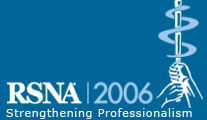
Abstract Archives of the RSNA, 2006
Claudio Saccavini PhD, Presenter: Nothing to Disclose
Marco Biasio, Abstract Co-Author: Nothing to Disclose
Paolo Inchingolo, Abstract Co-Author: Nothing to Disclose
Andrea Oliani MD, Abstract Co-Author: Nothing to Disclose
Marco Solfa, Abstract Co-Author: Nothing to Disclose
Gian Pietro Feltrin MD, Abstract Co-Author: Nothing to Disclose
To distribute radiological image and reports the common solution is to use a legacy application that normally is web based. We test the possibility to use the XDS (Cross Enterprise Document Sharing) profile in data distribution inside a Hospital Enterprise.
Before the introduction of XDS in Verona Hospital we used a in-house solution based on web technologies (Tomcat) that received the radiological reports in text format (ftp protocol) from the hospital RIS and transformed them into html pages.
In XDS approach we modify the previous application changing the technology from Tomcat to apache/php introducing a XDS Repository and a XDS Registry. These two parts are developed in to Open Three (O3) Consortium (www.o3consortium.org) that is an open source project.
We modify the RIS system to support the Document Source Actor to publish the reports into the Repository. Then we start a PACS that support Imaging Source actor.
The data viewer is modified to support the Document Consumer Actor and introducing a DICOM viewer (based on applet technology) to display radiological images. The same system is also integrated with the Hospital LIS (Laboratory Information System) and the Hospital CIS (Cardiology Information System).
The XDS approach is very useful to the implementation of Medical Record in different steps: first we distribute only the radiology reports, then we grow sharing every clinical document. Very important is the use of CDA format (Clinical Document Architecture by HL7) that substitute the first document format that are PDF. In this way every “consumer” can use the data atomicity in according with its business logic: for example in some application is sufficient to display Lab reports, but in other cases some application use the glucose value the draw curves.
XDS profile has been developed to share clinical documents among different hospitals (Cross Enterprise scenario), but it is very flexible to be use in the EHR-CR.
The use ooof integrated system to distribute radiological data together with Lab and Cardiology data is very usefull in clinical decisions.
Saccavini, C,
Biasio, M,
Inchingolo, P,
Oliani, A,
Solfa, M,
Feltrin, G,
Using XDS IHE Profile to Share Radiological Data in an Enterprise: the Verona Experience. Radiological Society of North America 2006 Scientific Assembly and Annual Meeting, November 26 - December 1, 2006 ,Chicago IL.
http://archive.rsna.org/2006/4441480.html

